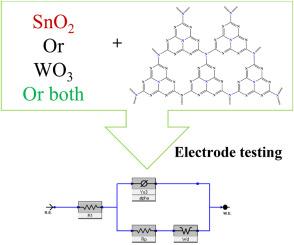Tailoring graphitic carbon nitride for ultracapacitor electrode application through nanocompositing with SnO2 and WO3
IF 4.7
3区 材料科学
Q2 MATERIALS SCIENCE, MULTIDISCIPLINARY
引用次数: 0
Abstract
Supercapacitors are a promising and necessary pillar that can aid the full-fledged adoption of intermittent renewable energy resources and emerging portable technologies. The performance of supercapacitors largely depends on the physicochemical properties of the electrode materials, which are centred on design and composition. The g-C3N4, as a 2D graphitic material, has long been recognised as a suitable electrode material for supercapacitors due to readily available sources. However, limited electro-active surfaces and low conductivities have posed significant challenges. Modifying physicochemical properties through compositing has emerged as a suitable approach to enhance their applicability in energy storage by generating hybrid electrode types. In this context, the current work investigated SnO2 nanoparticles and WO3 nanorods as enhancers of g-C3N4 nanosheets in binary (WO3-g-C3N4 and SnO2-g-C3N4) and ternary (SnO2-WO3-g-C3N4) nanocomposites for applications in supercapacitor electrodes. Properties were synergistically tailored; for instance, charge transfer resistance of SnO2-WO3-g-C3N4, g-C3N4, SnO2-g-C3N4, and WO3-g-C3N4 were 1.55, 1.26, 0.8 and 0.48 Ω, respectively. Consequently, incorporation of SnO2 and WO3 amplified energy storage by 119% and 172% in binary nanocomposites, while the ternary nanocomposites showed an improvement of 192%. The SnO2-g-C3N4, WO3-g-C3N4 and SnO2-WO3-g-C3N4 materials attained cycle stability of 70, 96, and 50%, respectively, after 2000 cycles. Other key synergism attributes from the work include morphological transformations that enhanced structural rigidity, intimate connectivity through chemical linkages, improved electro-active surfaces, and additional pseudo-capacitive contributions in the nanocomposites. The studied nanocomposites highlight that g-C3N4 can be favourably tuned in this manner and pave the way for significant potential in sustainable electrodes for abundant, clean, and renewable electrochemical energy.

用SnO2和WO3纳米复合定制用于超级电容器电极的石墨氮化碳
超级电容器是一个有前途和必要的支柱,可以帮助全面采用间歇性可再生能源和新兴的便携式技术。超级电容器的性能在很大程度上取决于电极材料的物理化学性质,这主要集中在设计和组成上。g-C3N4作为一种二维石墨材料,长期以来一直被认为是超级电容器的合适电极材料,因为它的来源很容易获得。然而,有限的电活性表面和低导电性构成了重大挑战。通过复合材料改变其物理化学性质已成为一种合适的方法,以提高其在储能方面的适用性,产生混合电极类型。在这种背景下,目前的工作研究了SnO2纳米颗粒和WO3纳米棒作为g-C3N4纳米片在二元(WO3-g-C3N4和SnO2-g-C3N4)和三元(SnO2-WO3-g-C3N4)纳米复合材料中的增强剂在超级电容器电极中的应用。属性是协同定制的;例如,SnO2-WO3-g-C3N4、g-C3N4、SnO2-g-C3N4和WO3-g-C3N4的电荷转移电阻分别为1.55、1.26、0.8和0.48 Ω。结果表明,SnO2和WO3的加入使二元纳米复合材料的储能性能分别提高了119%和172%,而三元纳米复合材料的储能性能提高了192%。经过2000次循环后,SnO2-g-C3N4、WO3-g-C3N4和SnO2-WO3-g-C3N4材料的循环稳定性分别达到70%、96%和50%。这项工作的其他关键协同作用属性包括增强结构刚性的形态转变、通过化学连接的紧密连接、改进的电活性表面以及纳米复合材料中额外的伪电容性贡献。所研究的纳米复合材料强调了g-C3N4可以以这种方式进行有利的调谐,并为可持续电极的巨大潜力铺平了道路,以获得丰富、清洁和可再生的电化学能源。
本文章由计算机程序翻译,如有差异,请以英文原文为准。
求助全文
约1分钟内获得全文
求助全文
来源期刊

Materials Chemistry and Physics
工程技术-材料科学:综合
CiteScore
8.70
自引率
4.30%
发文量
1515
审稿时长
69 days
期刊介绍:
Materials Chemistry and Physics is devoted to short communications, full-length research papers and feature articles on interrelationships among structure, properties, processing and performance of materials. The Editors welcome manuscripts on thin films, surface and interface science, materials degradation and reliability, metallurgy, semiconductors and optoelectronic materials, fine ceramics, magnetics, superconductors, specialty polymers, nano-materials and composite materials.
 求助内容:
求助内容: 应助结果提醒方式:
应助结果提醒方式:


